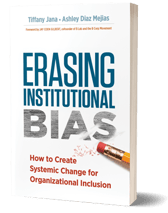When Tiffany and I began writing Erasing Institutional Bias: How to Create Systemic Change for Organizational Inclusion in the fall of 2017, the #metoo movement's broadscale rejection of sexual harassment and assault was beginning to gain steam. But we are here again: I am writing this in the wake of the Brett Kavanaugh confirmation. In the months prior to the Supreme Court hearings, many of the men who, it seemed, were finally facing consequences for assault and harassment against women began sliding back into the public eye, and not in infamy.
Many of us are waking up to what people facing oppression have always known: most institutions are structured to benefit only a few. What do we do now? And maybe, more poignantly, why do anything, when it seems that institutional bias and violent patriarchy keep winning?
So, what can I do?
There exist countless calls to civic engagement in order to confront institutional bias. Organize! Vote! Knock on doors and protest! In response to those calls, I've heard colleagues and friends say that activism and revolution can feel too far outside of our everyday lives, from the demands of workplace and the world. But to borrow from the liberation movements of the 1960s and 1970s, the work of confronting institutional bias is not as far off as it may seem – the personal is political.
We can take action in small ways, every day, to combat these systems that divide us. The biases we all harbor affect the communities of people we are with, the organizations we work in, and the communities we are part of. When these biases go unchecked, they become institutionalized and perpetuate, often without us even knowing it. How and where we work, who we hire, where we shop and who we eat with, and even what words we use in describing ourselves and others can either support institutional bias or protest against it. For example, in the debacle of the Ford-Kavanaugh hearings, our silence about our experiences of bias actually supports institutional bias. We can tell our stories to protest against it – in fact, it's one of the most effective things we can do.
It starts with stories
In our book, Erasing Institutional Bias: How to Create Systemic Change for Organizational Inclusion, we feature stories of individuals who have courageously confronted institutional bias, while also offering organizational tools for mapping a way forward when you find yourself facing institutional bias. We tell these stories to show what people have done in response to institutional bias, even when things can feel overwhelming.
In one story, the female CEO of a software firm wanted to cultivate a more equitable workplace and now maintains a 60% female leadership structure. When she was writing her first job description, she noticed that only men were applying. She noted, "When I started to dig into why, I realized I was playing into institutional bias in the way I wrote the job description. I actively sought feedback and was able to significantly change the ratio of women on our team." While her intention was to open the hiring opportunity to all, she realized, upon investigation, that her language and behavior in formulating the job description defaulted to cultural norms in her industry. While the desire to hire women was there, the language used to communicate company needs was inadvertently male-centric.
She began by evaluating her own role, and then determined a new pro-active role by deciding to be the one to re-write the job description to be more inclusive. She intentionally cultivated allies from within her organization by sharing the information she gathered, and then created a movement by writing about her experience – sharing her story – and giving keynotes at various conferences and events. Starting with her story enabled her to build accountability and measurement into the organization by committing to maintain a 60% female leadership structure.
But not all of the stories have happy endings. In these moments, it's all the more critical to comfort and support one another when they share their experiences. Telling stories—both when things work and when things don't—reminds us that the work isn't easy, nor is it finished.
Share your story and #Resist
We included all of these personal stories of facing bias—of being shamed, harmed, and subject to various forms of oppression—in Erasing Institutional Bias. We tell the stories with positive outcomes and the stories that leave us grieving—because the stories that we tell shape the world around us. When we share our stories, we create a chorus of resistance together and become better supporters of one another.
In an op-ed for the New York Times, published at the height of the Ford-Kavanaugh controversy, Jennifer Weiner wrote, "Stories matter tremendously. They're how we learn about who is real and who's less consequential; whose pain is important and whose, not so much; who is the hero and who is merely the hero's reward." We tell stories—both of what we have suffered and of the work we have done—to give one another a way forward and to remind one another that our work, our pain, our struggle, and our lives matter.

Ashley Diaz Mejias writes on race, systemic bias, and mass incarceration and works as a pastor in Richmond, VA. Erasing Institutional Bias: How to Create Systemic Change for Organizational Inclusion is her first book.




